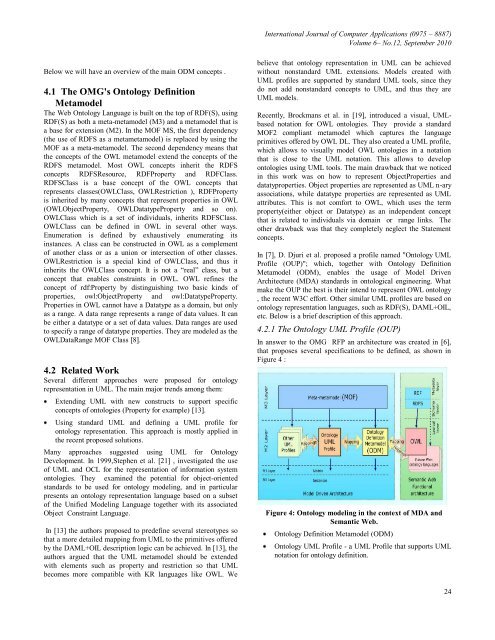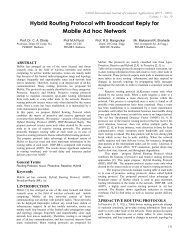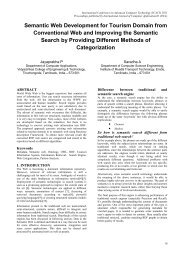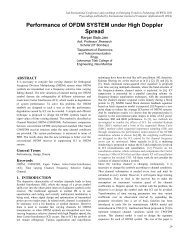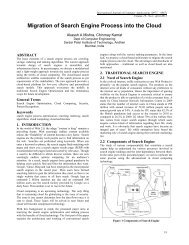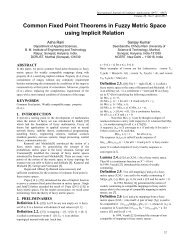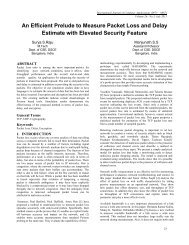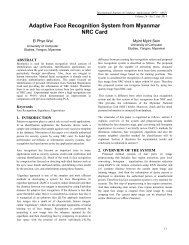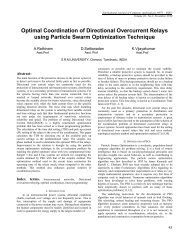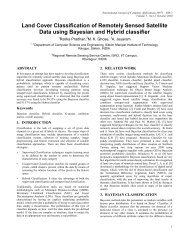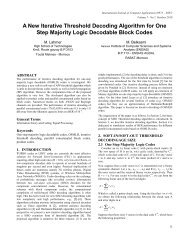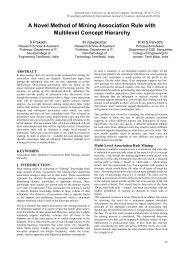Ontology Modeling Profile, an Extension for the ... - ResearchGate
Ontology Modeling Profile, an Extension for the ... - ResearchGate
Ontology Modeling Profile, an Extension for the ... - ResearchGate
You also want an ePaper? Increase the reach of your titles
YUMPU automatically turns print PDFs into web optimized ePapers that Google loves.
International Journal of Computer Applications (0975 – 8887)<br />
Volume 6– No.12, September 2010<br />
Below we will have <strong>an</strong> overview of <strong>the</strong> main ODM concepts .<br />
4.1 The OMG's <strong>Ontology</strong> Definition<br />
Metamodel<br />
The Web <strong>Ontology</strong> L<strong>an</strong>guage is built on <strong>the</strong> top of RDF(S), using<br />
RDF(S) as both a meta-metamodel (M3) <strong>an</strong>d a metamodel that is<br />
a base <strong>for</strong> extension (M2). In <strong>the</strong> MOF MS, <strong>the</strong> first dependency<br />
(<strong>the</strong> use of RDFS as a metametamodel) is replaced by using <strong>the</strong><br />
MOF as a meta-metamodel. The second dependency me<strong>an</strong>s that<br />
<strong>the</strong> concepts of <strong>the</strong> OWL metamodel extend <strong>the</strong> concepts of <strong>the</strong><br />
RDFS metamodel. Most OWL concepts inherit <strong>the</strong> RDFS<br />
concepts RDFSResource, RDFProperty <strong>an</strong>d RDFClass.<br />
RDFSClass is a base concept of <strong>the</strong> OWL concepts that<br />
represents classes(OWLClass, OWLRestriction ), RDFProperty<br />
is inherited by m<strong>an</strong>y concepts that represent properties in OWL<br />
(OWLObjectProperty, OWLDatatypeProperty <strong>an</strong>d so on).<br />
OWLClass which is a set of individuals, inherits RDFSClass.<br />
OWLClass c<strong>an</strong> be defined in OWL in several o<strong>the</strong>r ways.<br />
Enumeration is defined by exhaustively enumerating its<br />
inst<strong>an</strong>ces. A class c<strong>an</strong> be constructed in OWL as a complement<br />
of <strong>an</strong>o<strong>the</strong>r class or as a union or intersection of o<strong>the</strong>r classes.<br />
OWLRestriction is a special kind of OWLClass, <strong>an</strong>d thus it<br />
inherits <strong>the</strong> OWLClass concept. It is not a “real” class, but a<br />
concept that enables constraints in OWL. OWL refines <strong>the</strong><br />
concept of rdf:Property by distinguishing two basic kinds of<br />
properties, owl:ObjectProperty <strong>an</strong>d owl:DatatypeProperty.<br />
Properties in OWL c<strong>an</strong>not have a Datatype as a domain, but only<br />
as a r<strong>an</strong>ge. A data r<strong>an</strong>ge represents a r<strong>an</strong>ge of data values. It c<strong>an</strong><br />
be ei<strong>the</strong>r a datatype or a set of data values. Data r<strong>an</strong>ges are used<br />
to specify a r<strong>an</strong>ge of datatype properties. They are modeled as <strong>the</strong><br />
OWLDataR<strong>an</strong>ge MOF Class [8].<br />
4.2 Related Work<br />
Several different approaches were proposed <strong>for</strong> ontology<br />
representation in UML. The main major trends among <strong>the</strong>m:<br />
Extending UML with new constructs to support specific<br />
concepts of ontologies (Property <strong>for</strong> example) [13].<br />
Using st<strong>an</strong>dard UML <strong>an</strong>d defining a UML profile <strong>for</strong><br />
ontology representation. This approach is mostly applied in<br />
<strong>the</strong> recent proposed solutions.<br />
M<strong>an</strong>y approaches suggested using UML <strong>for</strong> <strong>Ontology</strong><br />
Development. In 1999,Stephen et al. [21] , investigated <strong>the</strong> use<br />
of UML <strong>an</strong>d OCL <strong>for</strong> <strong>the</strong> representation of in<strong>for</strong>mation system<br />
ontologies. They examined <strong>the</strong> potential <strong>for</strong> object-oriented<br />
st<strong>an</strong>dards to be used <strong>for</strong> ontology modeling, <strong>an</strong>d in particular<br />
presents <strong>an</strong> ontology representation l<strong>an</strong>guage based on a subset<br />
of <strong>the</strong> Unified <strong>Modeling</strong> L<strong>an</strong>guage toge<strong>the</strong>r with its associated<br />
Object Constraint L<strong>an</strong>guage.<br />
In [13] <strong>the</strong> authors proposed to predefine several stereotypes so<br />
that a more detailed mapping from UML to <strong>the</strong> primitives offered<br />
by <strong>the</strong> DAML+OIL description logic c<strong>an</strong> be achieved. In [13], <strong>the</strong><br />
authors argued that <strong>the</strong> UML metamodel should be extended<br />
with elements such as property <strong>an</strong>d restriction so that UML<br />
becomes more compatible with KR l<strong>an</strong>guages like OWL. We<br />
believe that ontology representation in UML c<strong>an</strong> be achieved<br />
without nonst<strong>an</strong>dard UML extensions. Models created with<br />
UML profiles are supported by st<strong>an</strong>dard UML tools, since <strong>the</strong>y<br />
do not add nonst<strong>an</strong>dard concepts to UML, <strong>an</strong>d thus <strong>the</strong>y are<br />
UML models.<br />
Recently, Brockm<strong>an</strong>s et al. in [19], introduced a visual, UMLbased<br />
notation <strong>for</strong> OWL ontologies. They provide a st<strong>an</strong>dard<br />
MOF2 compli<strong>an</strong>t metamodel which captures <strong>the</strong> l<strong>an</strong>guage<br />
primitives offered by OWL DL. They also created a UML profile,<br />
which allows to visually model OWL ontologies in a notation<br />
that is close to <strong>the</strong> UML notation. This allows to develop<br />
ontologies using UML tools. The main drawback that we noticed<br />
in this work was on how to represent ObjectProperties <strong>an</strong>d<br />
datatyproperties. Object properties are represented as UML n-ary<br />
associations, while datatype properties are represented as UML<br />
attributes. This is not com<strong>for</strong>t to OWL, which uses <strong>the</strong> term<br />
property(ei<strong>the</strong>r object or Datatype) as <strong>an</strong> independent concept<br />
that is related to individuals via domain or r<strong>an</strong>ge links. The<br />
o<strong>the</strong>r drawback was that <strong>the</strong>y completely neglect <strong>the</strong> Statement<br />
concepts.<br />
In [7], D. Djuri et al. proposed a profile named "<strong>Ontology</strong> UML<br />
<strong>Profile</strong> (OUP)"; which, toge<strong>the</strong>r with <strong>Ontology</strong> Definition<br />
Metamodel (ODM), enables <strong>the</strong> usage of Model Driven<br />
Architecture (MDA) st<strong>an</strong>dards in ontological engineering. What<br />
make <strong>the</strong> OUP <strong>the</strong> best is <strong>the</strong>ir intend to represent OWL ontology<br />
, <strong>the</strong> recent W3C ef<strong>for</strong>t. O<strong>the</strong>r similar UML profiles are based on<br />
ontology representation l<strong>an</strong>guages, such as RDF(S), DAML+OIL,<br />
etc. Below is a brief description of this approach.<br />
4.2.1 The <strong>Ontology</strong> UML <strong>Profile</strong> (OUP)<br />
In <strong>an</strong>swer to <strong>the</strong> OMG RFP <strong>an</strong> architecture was created in [6],<br />
that proposes several specifications to be defined, as shown in<br />
Figure 4 :<br />
Figure 4: <strong>Ontology</strong> modeling in <strong>the</strong> context of MDA <strong>an</strong>d<br />
Sem<strong>an</strong>tic Web.<br />
<strong>Ontology</strong> Definition Metamodel (ODM)<br />
<strong>Ontology</strong> UML <strong>Profile</strong> - a UML <strong>Profile</strong> that supports UML<br />
notation <strong>for</strong> ontology definition.<br />
24


